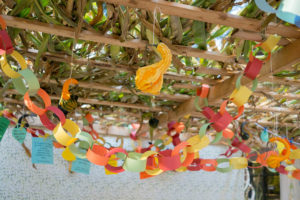Raise The Roof On The Symbolism of Sukkot
You shall dwell in huts (sukkot) for seven days. Every member of the Jewish people shall dwell in huts, so that your generations shall know that I had the Israelites dwell in huts when I took them out of Egypt.
Many years ago when I built my first sukkah in my own backyard, I was super excited to find a pile of freshly cut tree branches in the temple parking lot in carpool line.
It was fate. Or as we say in Hebrew, kismet. Since nobody else was claiming this tree limb treasure, I somehow managed to drag the logs like a lumberjack to my van and shove the messy branches into my newly vacuumed back seat. Little did I know these leafy sticks that I was about to lay on the roof of my sukkah had a name, s’chach  and I was doing a mitzvah.
Sukkot is the Hebrew name for the material used as a roof for a sukkah (booth), and for it to be a “kosher” sukkah the roof had to be made from things that have “grown from the ground.” These organic materials include palm leaves, bamboo sticks, pine tree branches, pruning from ornamental bushes, tall grasses or reeds, and even corn stalks. According to tradition, the sukkah h should be something that once grew in the earth but is no longer attached to the earth. So I began to collect weeping willow twigs and pine cones strewn in the lawn like they were gold.
Like most customs in Judaism, there are rules, and it can get kind of technical, but basically the schach should be thick enough to provide more shade than sun, but not so thick as to block out the stars at night. The concept of providing shade is deeply meaningful because it refers to the temporary huts that the children of Israel built while traveling the wilderness of Sinai. The sukkah symbolizes the “clouds of glory” that miraculously sheltered the Jewish people from the brutal desert sun.
Another rule is to add the roof, called schach, as the last step of building the sukkah, only after covering the walls is completed. Decorating the sukkah is the most fun–flowers, fruits, pine cone garlands, paper chains, and artwork depicting Jewish themes, while some people go all out and hang twinkling lights.
Like a crown in your very own tabernacle, the schach is filled with symbolism. Chassidic literature teaches that the words “sukkah“, as well as schach,” hint at the phrase “perceiving (in Hebrew, ‘sochei‘) with divine inspiration,” used to describe our matriarch Sarah, also known as “Isca” (from the same root letters). And it is while dwelling under the schach that we gain divine wisdom and understanding from Mother Nature, which is God’s gift to us. The sukkah reminds us that we don’t need the material things inside our homes to survive. Most often, the simpler our lives, the better.
The schach allows some light to come through, but doesn’t allow the bright sun to blind us. Meaning, the best way to be inspired, to see the light, is one ray at a time.
Sukkot is one of three pilgrimage festivals (the two other holidays are Passover and Shavuot) and are described in the Hebrew Bible as celebrating both agricultural festivals and historical events in the history of the Jewish people. Sukkot begins Friday, October 2, so get ready to see some weirdly shaped challahs and let’s raise the roof on schach.
Here’s more I wrote on Sukkot about the lulav and etrog.
Shabbat Shalom and Chag Sameach!


